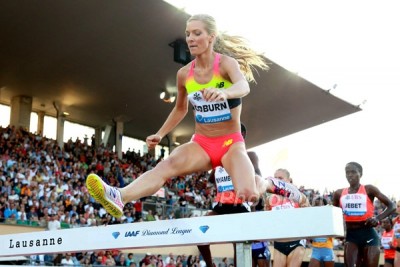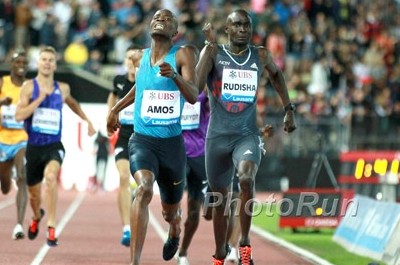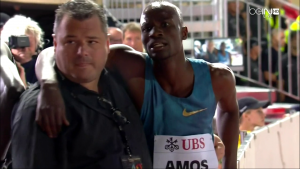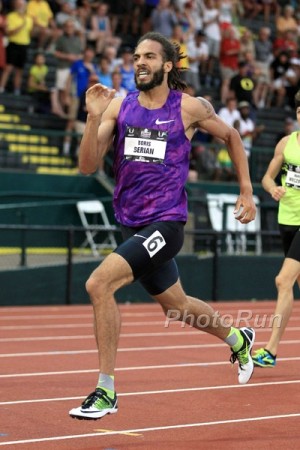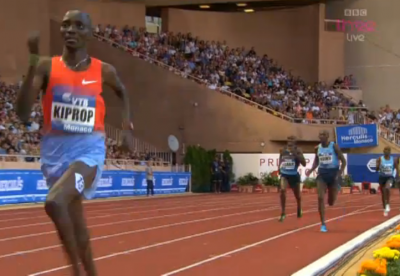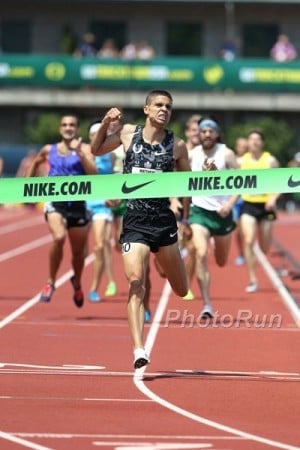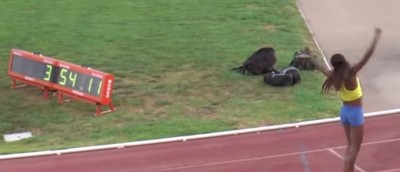Monaco Preview: What a Meet – Mo Farah & Genzebe Dibaba Drop Down to Face Loaded 1500 Fields; Souleiman vs. Amos vs. Aman at 800; A Loaded Women’s Steeple + Caleb Ndiku Tries Not To Fall
By LetsRun.com
July 15, 2015
The Monaco stop on the Diamond League circuit is always one of the best days on the track and field calendar, and this year’s meet on Friday is no exception. As always, the distance races are stacked. Mo Farah returns to the site of his stunning 3:28 from two years ago and tackles Asbel Kiprop, Taoufik Makhloufi, Matt Centrowitz and Leo Manzano in a loaded men’s 1500. The men’s 800 will see world leader Ayanleh Souleiman square off against Nijel Amos and Mo Aman. On the women’s side, both the 1500 and 3000 steeplechase could serve as World Championship previews as the five fastest 1500 women (including Genzebe Dibaba, Sifan Hassan and Jenny Simpson) and four fastest steeplers (including Virginia Nyambura, Hiwot Ayalew and Emma Coburn) are all entered.
There will be some great sprint/jumps events too, led by the men’s triple jump. Olympic champ Christian Taylor and world leader Pedro Pablo Pichardo will reprise their epic competition from Lausanne, and they’ll face USA indoor/outdoor champ Omar Craddock and NCAA champ Marquis Dendy (making his DL debut). The women’s 100 hurdles will be predictably competitive again, with the usual faces in action: U.S. champ Dawn Harper-Nelson (who won last week in Lausanne), world leader Sharika Nelvis and defending world champ Brianna Rollins, to name a few. The men’s 100 should also be a treat with Justin Gatlin looking for another sub-9.80 against U.S. champ Tyson Gay and Frenchman Jimmy Vicaut, whose 9.86 in Lausanne tied the European record.
Monaco annually produces some of the best races and fastest times of the summer, so you won’t want to miss this meet.
We preview all the mid-d/distance action below in detail.
What: 2015 Herculis
Where: Stade Louis II, Fontvieille, Monaco
When: Friday, July 17. Field events begin at 12:30 p.m. ET; DL track events (and the beIN Sports broadcast) begin at 2:00 p.m. ET.
How to watch: Live on beIN Sports from 2:00 p.m. ET to 4:00 p.m. ET. In Europe, you can watch the meet live on Eurosport. Details on the TV/streaming information here.
Schedule/entries/results * TV/streaming information * 2014 LRC coverage
Just how fast are the mid-d/distance races in Monaco? There were five mid-d/distance events last year and four of them produced times that would end up as the fastest of 2014. Check out the table below.
| Event | Winner | Time | World Leader? | Comment |
| M1500 | Silas Kiplagat | 3:27.64 | Yes | Fastest time in world since ’04; 7 men under 3:30; race produced 7 of top 9 times in ’14 |
| M3000SC | Jairus Birech | 8:03.33 | No | Wound up as #4 time of ’14 |
| W800 | Ajee Wilson | 1:57.67 | Yes | Race produced #1, #3, #9 and #10 times of ’14 |
| W5000 | Genzebe Dibaba | 14:28.88 | Yes | Race produced 8 of 12 fastest times in ’14, including top 3 |
| M800 | Nijel Amos | 1:42.45 | Yes | Race produced top 5 times of ’14; 2nd race in history (after ’12 OG final) with 5 sub-1:43s |
And last year was no outlier. Check out what happened in the three years before that:
2013 Herculis
World leaders: M5000 (12:51.34, Edwin Soi), M1500 (3:27.72, Asbel Kiprop)
Notes: Kiprop’s time was the fastest since 2004; Mo Farah set a European record in second (3:28.81)
2012 Herculis
World leaders: M1500 (3:28.88, Asbel Kiprop)
Notes: Kiprop’s time was the fastest since 2004; W3000 featured 5 of the year’s top 7 times
2011 Herculis
World leaders: M3000SC (7:53.64, Brimin Kipruto), M5000 (12:53.11, Mo Farah)
Notes: Kipruto missed the WR by .01; runner-up Ezekiel Kemboi’s 7:55.76 remains his PR and was sixth-fastest time ever at the time (now seventh); only second steeple in history with three men sub-8:00 (first with three sub-7:58); M5000 featured 3 fastest times on the year, including British (Farah) and American (Bernard Lagat, 12:53.60) national records; M800 featured #2 and #5 times on the year; M1500 featured #2 time on the year
Add up the fast fields and Monaco’s history of producing blazing times (particularly on the men’s side) and it’s likely that at least one of the distance races on Friday goes very, very fast. But which one? Let’s rank them from least to most likely to produce historically fast times.
5. Men’s 3000 (2:55 p.m. ET)
| Name | Country | PB | SB |
| Yenew Alamirew | Ethiopia | 7:27.26 | 7:46.23 |
| Ben Blankenship | USA | 7:47.07 | |
| Jesus Espana | Spain | 7:38.26 | |
| Dejene Gonfa | Ethiopia | 7:43.94 | 7:43.94 |
| Yasin Haji | Ethiopia | 7:59.42 | 7:59.42 |
| Garrett Heath | USA | 7:44.87 | |
| Ali Kaya | Turkey | 7:55.42 | 7:55.42 |
| Isiah Koech | Kenya | 7:30.43 | 7:40.39 |
| Hillary Maiyo | Kenya | 7:42.37 | 7:42.37 |
| Caleb Ndiku | Kenya | 7:30.99 | |
| Geoffrey Rono | Kenya | ||
| Edwin Soi | Kenya | 7:27.55 | 7:41.69 |
There are some fast guys in this race, no doubt, but comparatively, this is the weakest of the five mid-d/distance events in Monaco. The best guy in this race, Caleb Ndiku, fell in his season debut in Lausanne last Thursday, during which he was spiked and later required staples in his foot. After the race, his coach Renato Canova posted on LetsRun.com that Ndiku would not run again until Tuesday at the earliest and that his status for this race was in doubt. We still don’t know what kind of shape Ndiku, last year’s world indoor champ at 3,000, is in, seeing as his fall-marred race in Lausanne was his 2015 opener, but even if he does toe the line in Monaco, he’s going to be less than 100%. Still it’s important for him to get an all out effort in.
2013 world bronze medalist Isiah Koech (second at Kenyan champs last week), 2008 Olympic bronze medalist Edwin Soi (third in Lausanne) and 2014 world junior silver medalist Yasin Haji (fourth in Lausanne) enter in good form, while Turkey’s Ali Kaya (dominant wins in 5,000 and 10,000 at Euro U-23 champs) and Garrett Heath (fourth at USAs) also have the chance to turn some heads. Ben Blankenship is also an interesting prospect, as he was having a tremendous year before finishing an agonizing fourth at USAs in the 1500. However, his European opener in Lucerne on Tuesday was not impressive (he was seventh in 8:02 in a race that Lopez Lomong won in 7:42); can he turn it around with just two days of rest in Monaco?
4. Women’s 3,000 steeplechase (3:45 p.m. ET)
| Name | Country | PB | SB |
| Birtukan Alemu | Ethiopia | 9:24.91 | 9:24.91 |
| Hiwot Ayalew | Ethiopia | 9:09.61 | 9:16.87 |
| Amina Bettiche | Algeria | 9:40.24 | 9:29.20 |
| Emma Coburn | USA | 9:11.42 | 9:15.59 |
| Maeva Danois | France | 9:40.89 | 9:40.89 |
| Salima El Ouali Alami | Morocco | 9:28.49 | 9:21.24 |
| Ann Gathoni | Kenya | 9:41.40 | 9:41.40 |
| Tigist Getent | Bahrain | 9:27.07 | 9:27.07 |
| Habiba Ghribi | Tunisia | 9:08.37 | |
| Ruth Jebet | Bahrain | 9:20.55 | 9:26.87 |
| Purity Kirui | Kenya | 9:19.42 | 9:33.41 |
| Hyvin Kiyeng | Kenya | 9:15.08 | 9:15.08 |
| Gesa Krause | Germany | 9:23.52 | 9:36.21 |
| Genevieve LaCaze | Australia | 9:33.19 | 9:35.17 |
| Diana Martin | Spain | 9:30.70 | 9:46.37 |
| Virginia Nyambura | Kenya | 9:15.75 | 9:15.75 |
| Leah O’Connor | USA | 9:31.03 | 9:31.03 |
| Aisha Praught | Jamaica | 9:34.69 | 9:36.63 |
Yes, this race is loaded with talent, including the four fastest women on the year and all three DL winners so far. The problem is that the women’s steeple simply hasn’t been a very fast event in 2015. Hyvin Kiyeng‘s current world leader of 9:15.08 in Rome is almost five seconds slower than Hiwot Ayalew‘s 9:10.64 from last year and if it holds up would stand as the slowest world leader since 2006. And it’s not just at the top; across the board, times have been slower in international steeples this year.
| Athlete | 2014 SB | 2015 SB | Difference |
| Hiwot Ayalew | 9:10.64 | 9:16.87 | +6.23 |
| Sofia Assefa | 9:11.39 | 9:23.04 | +12.65 |
| Emma Coburn | 9:11.42 | 9:15.59 | +4.17 |
| Habiba Ghribi | 9:15.23 | N/A | N/A |
| Etenesh Diro Neda | 9:19.71 | 9:29.10 | +9.39 |
Statistics can be misleading without the proper context, however, and there are several reasons for the dearth of fast times in the steeple this year:
1) Poor racing conditions
There have been five DL steeples so far, but of those five, only one has had good conditions for running fast — Rome on June 4 (unsurprisingly, that race produced five of the six fastest times on the year). The DL opener in Doha was run in 100-degree temps; NYC on June 13 wasn’t much better, with temps in the 90s. Birmingham on June 7 was windy (and only three days after Rome, to boot). So too was Lausanne last week, where Coburn noted that conditions weren’t good for running fast.
2) Slow fields
Many of the top women from the last few years simply haven’t raced many steeples in 2015. Coburn, Ghribi and Diro Neda, three of last year’s top five, have combined to race twice on the DL circuit. Defending world champ Milcah Chemos is out for the year with an injury; Olympic champ Yuliya Zaripova is serving a doping ban. Coburn and Ghribi will both be in action in Monaco, which should make for a faster race.
3) It’s mid-July
The top women will all be peaking for Worlds, so it’s reasonable to assume that the top women will gain fitness as the year goes on. That means that we should see faster times in the three major steeples remaining on the calendar: Monaco, Worlds and the DL final in Brussels on September 11.
Fortunately, the first two issues shouldn’t be a problem in Monaco. Though it will be warm on Friday (forecast calls for low-80s) the wind should die down by the evening and the track in Monaco is always fast. And the field is the best assembled for a steeple all year, with Coburn and Ghribi (running her first race since February) both on the start list.
This should be a terrific race, and a world leader seems very likely. With no more DL steeples between now and Worlds, this is the last chance for many of these women to post a fast time before Beijing. But more than that, it will give us our best look yet at the steeple picture at Worlds. Kenya’s 21-year-old Virginia Nyambura, a 9:58 performer at year’s start, is the presumptive favorite right now, with DL finishes of 1st, 2nd, 1st and 1st, most recently winning in Lausanne last week.
There are several women capable of beating her, however. Recently-crowned Kenyan champ Hyvin Kiyeng is the world leader at 9:15.08 and the only woman to defeat Nyambura in 2015. Coburn had a bad race in Lausanne (third in 9:20.67) but she’s looked great apart from that, running a 1500 pb of 4:05.10 and decimating a solid field at USAs with a 9:15.59 solo effort in 90-degree temps. 2011 World/2012 Olympic silver medalist Habiba Ghribi is a huge wildcard as she hasn’t raced at all this year outdoors, but she traditionally comes on strong at the end of the year.
Monaco should help sharpen the medal picture prior to Worlds, but barring a dominant win by one athlete, this event figures to be one of the most wide-open on the docket.
| [gravityform action=”polls” id=”222″ mode=”poll” cookie=”1 month” show_results_link=”false” display_results=”true” percentages=”true” counts=”false” ajax=”true”] |
3. Men’s 800 (2:35 p.m. ET)
| Name | Country | PB | SB |
| Mo Aman | Ethiopia | 1:42.37 | 1:43.56 |
| Nijel Amos | Botswana | 1:41.73 | 1:43.80 |
| Boris Berian | USA | 1:43.84 | 1:43.84 |
| Pierre-Ambroise Bosse | France | 1:42.53 | 1:43.88 |
| Ferguson Rotich Cheruiyot | Kenya | 1:42.84 | 1:44.00 |
| Alfred Kipketer | Kenya | 1:43.95 | 1:44.59 |
| Adam Kszczot | Poland | 1:43.30 | 1:43.94 |
| Marcin Lewandowski | Poland | 1:43.79 | 1:44.25 |
| Bram Som | The Netherlands | 1:43.45 | |
| Ayanleh Souleiman | Djibouti | 1:43.08 | 1:43.08 |
| Amel Tuka | Bosnia & Herzegovina | 1:43.84 | 1:43.84 |
This race could easily go extremely fast and prove us wrong, but here’s the thing: even if this thing’s won in 1:42-low, it may not be the best race of the night. Last year, Nijel Amos ran 1:42.45 to lead five men under 1:43 for just the second time in history. Yet it was still overshadowed by the ridiculous men’s 1500, which LRC readers voted as the best race of 2014.
One reason to think this year’s race may not be quite as fast as last year’s is that there’s no David Rudisha. Rudisha’s front-running style often gets the pace going and helps drag the runners behind him to fast times. Without him, someone else will have to do the work.
Fortunately, there are several runners still capable of running very fast. 2013 World bronze medalist Ayanleh Souleiman blasted a 1:43.08 world-leader in Barcelona last week without Rudisha in the field and he’s been on a tear this year, running well across a variety of distances. He’s also already won one 800 on the circuit, claiming the DL opener in Doha in 1:43.78. As we stated last week after Lausanne, defending world champ Mo Aman hasn’t been his consistent self in 2015, bookending two wins in Eugene and Rome with a ninth in Doha (on May 15) and an eighth in Lausanne (on July 9). At his best, Aman is nearly untouchable, and given that he never runs two bad races in a row, expect him to finish no lower than third in Lausanne.
Calling Nijel Amos favorite for gold in Beijing is tough, but given his dominant 2014 and his recent hot streak (no losses since June 4, including a 21.34 200 win in Germany and DL victories in Birmingham and Lausanne), his career winning head to head record against both Aman and Rudisha, he should get the slight nod over Aman and Rudisha. Watching him take on Aman and Souleiman on Friday should be a real treat.
The only concern is that Amos looked like this when we last saw him a few minutes after hiw win in Lausanne last week:
He had to be helped off the track. Hopefully the injury was a minor one, but we won’t know for sure until Amos takes the track in Monaco.
The Bosnian Amel Tuka? Or the American Boris Berian ?
Another subplot to watch in Monaco is how two of the world’s breakout 800 runners will fare in their first head-to-head matchup. At the start of the year, few would have predicted that the list of the world’s sub-1:44 runners in 2015 would include Boris Berian of the U.S. and Amel Tuka of Bosnia & Herzegovina. Yet both enter Friday’s race with identical 1:43.84 SBs/PRs. We chart their progress below.
Amel Tuka (age 24)
PR at start of year: 1:46.12
PR #1: 1:44.19 (July 1, Velenje)
PR #2: 1:43.84 (July 11, Madrid)
Boris Berian (age 22)
PR at start of year: 1:48.89
PR #1: 1:46.16 (April 11, Tempe)
PR #2: 1:45.30 (May 2, Stanford)
PR #3: 1:43.84 (June 13, New York)
The question now becomes how much better can the two get, not only this year, but in their careers? Berian is two years younger and has made a bigger improvement this year, but he didn’t even make the final at USAs and won’t have a chance to run at Worlds. Tuka faces no such problem; he’s the only Bosnian with the IAAF standard of 1:46.00 (the next-fastest is Dusan Babic at 1:48.94) and will be at Worlds barring injury.
Monaco represents the best field either runner has faced to this point in his career, and aside from the opportunity to run fast, it also offers each a chance to experience what it’s like to run against the best in the world, something they’ll have to get used to if they are to continue to make progress.
| [gravityform action=”polls” id=”223″ mode=”poll” cookie=”1 month” show_results_link=”false” display_results=”true” percentages=”true” counts=”false” ajax=”true”] |
2. Men’s 1500 (2:15 p.m. ET)
| Name | Country | PB | SB |
| Morhad Amdouni | France | 3:35.17 | 3:35.17 |
| Robert Biwott | Kenya | 3:31.39 | 3:31.39 |
| Matthew Centrowitz | USA | 3:31.09 | 3:37.25 |
| Collins Cheboi | Kenya | 3:31.53 | 3:31.88 |
| Mo Farah | Great Britain | 3:28.81 | |
| Abdelaati Iguider | Morocco | 3:29.83 | 3:36.28 |
| Henrik Ingebrigtsen | Norway | 3:31.46 | 3:32.85 |
| Asbel Kiprop | Kenya | 3:27.72 | 3:36.9h |
| Jackson Kivuva | Kenya | 3:41.63 | |
| Taoufik Makhloufi | Algeria | 3:30.40 | 3:30.50 |
| Elijah Manangoi | Kenya | 3:34.88 | 3:34.88 |
| Leo Manzano | USA | 3:30.98 | 3:38.76 |
| Andrew Rotich | Kenya | 3:43.43 | |
| Nick Willis | New Zealand | 3:29.91 | 3:39.31 |
| Aman Wote | Ethiopia | 3:29.91 | 3:32.03 |
Bold = set PR in Monaco
#2? For the event that’s produced winning times of 3:28.88, 3:27.72 and 3:27.64 over the past three years?
Yes. You could argue that because the men’s 1500 world record of 3:26.00 is closer to being broken than the women’s mark of 3:50.46, the men’s 1500 is more likely to produce historically fast times. Technically, you’re correct. But given that many of the all-time marks on the women’s side are questionable, Dibaba’s 3:54.11 in Barcelona last week could be the fastest clean time in history. And for that reason, we’re going with the women’s 1500 as the race most likely to produce fireworks on Friday.
That’s not to say the men’s 1500 will be dull. This has been the race of the meet for the last three years, and even though Asbel Kiprop has said he won’t be gunning for the world record this time, that may be a smart move by Kiprop as unlike some year’s past, he clearly seems to slowly be building his fitness. In 2012 and 2014, Kiprop ran 3:29 for 1500 in early May. Of course, when the Olympics rolled around in 2012, Kiprop was hurt. This year, Kiprop seems he’s plenty fit (winning the Kenyan national 800 title last week, althought he labelled his fitness at only 70% last week) and ready to take on Mo Farah but focused fully on August.
No one runs world records by accident these days, so the chances of a 3:26 or faster are essentially zero. But Monaco is going to be fast. Just look at the start list and the column labeled “PB.” Of the 13 racers (Jackson Kivuva and Andrew Rotich are likely to be rabbits), 10 set their PBs in Monaco. Ayanleh Souleiman and Silas Kiplagat won’t be in the 1500 in Monaco, so the race won’t be a true Worlds preview, but it remains very intriguing. Here are a few of the best storylines.
1. Kiprop vs. Farah, Round II
The only head-to-head meeting between the reigning world champions came on this track two years ago, and it produced a couple of shocking times. The first was Kiprop’s 3:27.72, the fastest time in the world since 2004 and at that point good enough to make Kiprop the fourth-fastest performer in history (Kiplagat’s 3:27.64 in Monaco the next year bumped him down to #5). The time and identity of the second-place finisher was even more shocking as Farah, who won the Olympic 10,000 title less than a year earlier, unleashed a 3:28.81 European record, putting him sixth on the all-time list (he’s now tied for seventh). A month after their titanic clash, both added world titles in Moscow (Kiprop in the 1500, Farah in the 5,000 and 10,000) and the two have continued to impress in the ensuing two years.
Both enter Monaco in terrific form. Kiprop won his last DL outing in Oslo, claiming the Dream Mile on June 11, before adding a national title at 800 meters on July 11. Farah has won his last two track races, the Pre Classic 10,000 on May 29 and the Lausanne 5,000 on July 9, but he hasn’t run a 1500 — or any race shorter than 3,000 meters — since Monaco two years ago. At age 32, does he still have the speed to hang with Kiprop?
2. America’s Best
The U.S.’s two best 1500 runners of the 2010s, Matthew Centrowitz and Leo Manzano, both set PRs in this race last year (Manzano was eighth in 3:30.98, Centrowitz ninth in 3:31.09) and while PR’ing on Friday would be nice, that’s not the primary objective for either of them. Manzano’s goal is simple and easily attainable for him: run the 3:36.20 IAAF standard to lock in his spot on Team USA. Manzano has run that time in each of the past six years and given the fast nature of the race in Monaco, he should manage that easily.
Centrowitz has dominated the domestic scene this year, taking commanding victories at USA indoors and outdoors. His goal will be loftier: win the race. That won’t be easy with Kiprop and Farah and the Olympic champ Taoufik Makhloufi (who has run 2:13.08 for 1k and 3:30.50 for 1500 this year) in the field, but Centrowitz has already beaten Kiprop this season at Prefontaine. Traditionally Centrowitz has struggled to contend in fast European races, but he’s ascended to a different level in 2015. He should already be regarded as a gold medal threat at Worlds, but if he can beat Kiprop in a 3:30/3:31 race, that will send a message loud and clear to 1500 runners across the globe.
Both Centro and Leo will also be looking to add their names to the very short list of Americans to break 3:30 in the 1500. Currently, the list numbers two men, Bernard Lagat and Sydney Maree. If Centro can do it, he’ll become the first American-born man in history to accomplish the feat.
But this is an important race for Centro. If he bombs, grave doubts will start coming out about his Beijing prospects. Why? Because he bombed his 2015 European debut last week in Lausanne when he only ran 1:49 for 800. But then again normal rules don’t apply when evaluating European performances for Centrowitz. Why? Well in 2013, before Worlds, he was a DNF in Paris, 8th in Monaco and then 16th in London before getting 2nd at Worlds. In 2011, he was 11th in Paris and 10th in Monaco before getting third at Worlds.
Centrowitz is an incredible tactical racer. Let us share an anecdote. We recently were told a top agent, who works with many top African runners, watched the US 1500 this year where Centro closed his last 600 in 1:18.1 (MB: Centro: fastest last 600 in a 1500 ever? (1:18.1)) and when it was done simply said something along the lines of, “The Kenyans can’t close that fast. They aren’t that powerful.”
3. Olympic medalists to watch for
2012 Olympic champ Taoufik Makhloufi “only” finished fourth in Paris in 3:30.50, but he lost to three true studs in Kiplagat, Souleiman and Ronald Kwemoi, none of whom will be in this race. That makes Makhloufi, who blitzed a 2:13.08 1000 on July 1, a serious threat for the win here.
2008 Olympic silver medalist Nick Willis is a less obvious threat for the win, but he bears watching as his outdoor season is just now kicking into gear. Though he ran a few outdoor races in his native New Zealand in March, claiming the NZ national 1500 title, he didn’t run another until June, where he was outkicked by Ben True in the 5,000 in New York. He took another break until his next race, a 3:39.31 1500 victory in Lignano on July 7. Now he gets his first real test at his best distance, and he’s ready for the challenge, running 1:46.9 for 800 in practice on Tuesday. Willis broke 3:30 for the first time in this race last year; how fast can he go in 2015?
| [gravityform action=”polls” id=”224″ mode=”poll” cookie=”1 month” show_results_link=”false” display_results=”true” percentages=”true” counts=”false” ajax=”true”] |
| [gravityform action=”polls” id=”225″ mode=”poll” cookie=”1 month” show_results_link=”false” display_results=”true” percentages=”true” counts=”false” ajax=”true”] |
1. Women’s 1500 (3:25 p.m. ET)
| Name | Country | PB | SB |
| Genzebe Dibaba | Ethiopia | 3:54.11 | 3:54.11 |
| Axumawit Embaye | Ethiopia | 4:02.35 | 4:03.00 |
| Sofia Ennaoui | Poland | 4:04.90 | 4:04.90 |
| Kerri Gallagher | USA | 4:03.56 | 4:03.56 |
| Sifan Hassan | The Netherlands | 3:57.00 | 3:59.68 |
| Maureen Koster | The Netherlands | 4:02.64 | 4:02.64 |
| Laura Muir | Great Britain | 4:00.07 | 4:00.39 |
| Chanelle Price | USA | 4:16.52 | 4:21.70 |
| Shannon Rowbury | USA | 3:59.49 | 4:02.28 |
| Basu Sado | Ethiopia | 4:07.59 | 4:07.82 |
| Dawit Seyaum | Ethiopia | 3:59.53 | 3:59.76 |
| Anna Shchagina | Russia | 4:04.30 | 4:04.30 |
| Jenny Simpson | USA | 3:57.22 | 3:59.31 |
| Tamara Tverdostup | Ukraine | 4:07.43 | 4:11.74 |
| Laura Weightman | Great Britain | 4:00.17 | 4:04.70 |
We don’t know whether Genzebe Dibaba will attempt the 1500/5,000 double at Worlds, but she will take on the world’s best at 1500 in Monaco, so let’s appreciate this race. Plus how she does here, may impact what she decides to do in Beijing.
Dibaba has fearlessly attacked races from the front this year (though Almaz Ayana may argue she showed some fear by not leading enough laps in their 5,000 WR attempt in Paris), most recently running a jaw-dropping 3:54.11 in Barcelona last week, the ninth-fastest time in history and the fastest in 18 years. It will be fascinating to see what approach she uses in this race. Usually it’s foolish to try to go wire-to-wire in a Diamond League 1500, but when your PR is almost three seconds better than the next-fastest runner’s — as is the case with Dibaba — it could be a winning strategy.
Ideally, Dibaba would be able to run two DL 1500s before Worlds. In one, she could run a more tactical race and see whether her 3:54 speed is enough to outkick everyone at the end. In the other, she could run it from the front and see whether anyone could match her 14:15 5,000 strength. Unfortunately for her, there is only one DL 1500 remaining after Monaco, and it doesn’t come until September 11 in Brussels. So she’ll have to pick a strategy here and then make a decision about Beijing.
Dibaba is no lock for the win in Monaco, however. She ran 3:55.17 indoors last year but came up short in her only outdoor 1500, as Jenny Simpson ran her down over the final 100 to win in Stockholm on August 21. Simpson also got the best of Dibaba in the 1500 at Worlds in 2013 (she finished second to Dibaba’s eighth). In fact, Simpson is 3-1 all-time vs. Dibaba over 1500 meters. It’s obviously scary to face a woman with a 3:54.11 PR — over three seconds better than Simpson’s 3:57.22 — but if Simpson is there with 100 to go, she will be very dangerous.
Sifan Hassan is the other major threat to Dibaba as she has won her last two 1500s, in Birmingham on June 7 and in Lausanne last week, where she became the first woman to defeat Simpson over that distance in 2015. Hassan’s 3:57.00 pb isn’t close to Dibaba’s, but it’s still plenty fast and she’s proven she can close out races with the best of them. U.S. runner-up Shannon Rowbury and 2015 DL winners Laura Muir (Oslo) and Dawit Seyaum (Doha) have all also run well at times this year and have a shot to break up the top three.
With Dibaba, Simpson and Hassan, you’ve got the three best 1500 runners in the world right now, but what makes this race appealing is the potential for a very, very fast time. Dibaba never hesitates to go with the rabbit and if she does that, Simpson and Hassan will have little chance but to follow her, lest she create an insurmountable gap, as Muir did to win in Oslo. After her win at USAs, Simpson said she wasn’t going to chase Mary Decker‘s 3:57.12 American record this summer, but if Dibaba commits to a fast pace up front, the record could be a happy byproduct for Simpson. The rest of the field — including two of the other runners on Team USA in the 1500, Rowbury and Kerri Gallagher — stands to benefit as well, just as Asbel Kiprop’s front-running produced a slew of PRs in the men’s 1500 last year.
More: Discuss the meet in our fan forum: MB: Official 2015 Monaco Diamond League Discussion Thread.
| [gravityform action=”polls” id=”226″ mode=”poll” cookie=”1 month” show_results_link=”false” display_results=”true” percentages=”true” counts=”false” ajax=”true”] |
| [gravityform action=”polls” id=”227″ mode=”poll” cookie=”1 month” show_results_link=”false” display_results=”true” percentages=”true” counts=”false” ajax=”true”] |
- Professional
- Previews
- LRC
- Women's Running
- Men's Running
- Distance
- Events
- Mid-Distance
- Mo Farah
- Jenny Simpson
- 800
- Nick Willis
- 1500
- Asbel Kiprop
- 3000 Steeple
- 3000
- Matthew Centrowitz
- Nijel Amos
- Sifan Hassan
- Leo Manzano
- Emma Coburn
- Virginia Nyambura
- Ayanleh Souleiman
- Genzebe Dibaba
- Mo Aman
- Habiba Ghribi
- 2015 Diamond League
- Hyvin Kiyeng
- Boris Berian
- 2015 Herculis Monaco
- Amel Tuka








